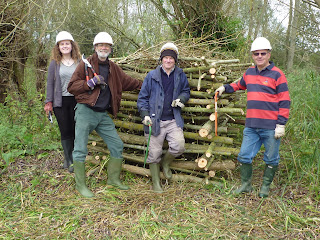Changes in ditch management over the years. April 2020.
In the early 1970s, the current path system was established by the first groups of volunteers to working on the reserve. What they did was to dig out two spade spits on either side and heap the marsh clay etc into the middle to make a kind of raised path.
Up until the 1990s these ditches were maintained by using top spades and crome forks to periodically dig out sections and maintain some open water. A shovel was adapted using a piece of black plastic bucket to make a ‘slubbing shovel’ as used to be used on the Norfolk Broads and Cambridgeshire Fens.
In 2015 , the creation of Water Vole habitat was started when a 17 ton excavator was used to dig out ditches in the southern section of the reserve. The practice was hugely destructive as can be seen from the photographs and the idea was to create Water Vole ditches which would have water of sufficient depth for diving and swimming and also to create some more some substantial paths for the Voles to burrow into. Previous to this operation the ditches had an interesting fauna of 9/12 Spined Sticklebacks which even seemed to survive drought conditions. It will be interesting to see if any of this population have survived.
The new layout of the ditches can be seen from the Google Earth image, ‘bunds’ were left at intervals to try and forestall the new ditches simply draining the marsh. At the North end which was dug in 2016 a new ditch line was dug where previously there had only been a shallow depression. This has resulted in their being much more water at this end of the reserve than should be and has led to the formation of wet woodland. In the authors opinion a hydrology survey should have been carried out beforehand because it is almost certain that the existing spring line has been cut into which is where all the water is coming from.
It has been suggested that the digger returns to ‘slop out’ the ditches. The current Warden is strongly resisting this because it is hugely damaging and is only a temporary solution because Reed Mace and Branched Bur Reed very quickly recolonise the ditches even if they are removed by digging out. The sediment is also organic not mineral and what would be ‘slopped out’ would literally be muddy water along with all the fauna and flora that goes with it. There is also, of course, the additional consideration that there is now a thriving colony of Water Voles on the reserve and having an excavator on site is hardly compatible with encouraging these mammals.
At the present time the most effective way of preventing succession in the ditches seems to be to actually get somebody into the water wearing chest waders. They can then quite easily pull up Reed Mace and Branched Bur Reed. This has to be done before Christmas because the water is still relatively warm and if it is left until the New Year it becomes uncomfortably cold.
A new strategy that is being investigated is the use of a ‘scythet’ which can be used to cut off the new shoots of encroaching water plants. An experimental stretch of ditch treated in this way in 2019, showed that if these new shoots are cut off early in the season then they do not regrow and this may well be a viable method of keeping the ditches open. The aim is to have a mosaic of habitats from open water through to advancing succession. For the first time this year one of the newly cleared sections had frogspawn which is a first for the ditches in this part of the reserve.



















Comments
Post a Comment